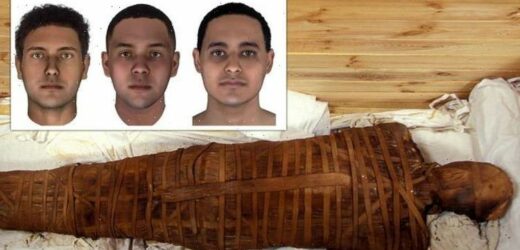Egyptian ‘mega-tomb’ uncovered in Saqqara region of Cairo
We use your sign-up to provide content in ways you’ve consented to and to improve our understanding of you. This may include adverts from us and 3rd parties based on our understanding. You can unsubscribe at any time. More info
The trio came from Abusir el-Meleq, an ancient city on a floodplain to the south of Cairo and they were estimated to be buried between 780 BC and 5 AD. Their DNA was first sequenced in 2017 by scientists at the Max Planck Institute for the Science of Human History in Tubingen, Germany. That has now allowed researchers at Parabon NanoLabs, a DNA technology firm in the US, to create 3D models of the mummies’ faces with the help of a process known as forensic DNA phenotyping.
The process is used to predict genetic ancestry, eye colour, hair colour, skin colour, freckling, and face shape in individuals from any ethnic background.
It uses the information to then build a computer-generated e-fit.
The technology has also been used to generate leads in criminal cases, but the company said it was “the first time” it has been “performed on human DNA of this age”.
The team found the Egyptian men has light brown skin with dark eyes and hair.


They said the genetic makeup was closer to that of modern individuals in the Mediterranean or the Middle East than it was to modern Egyptians.
Experts also highlighted the differences between the three men by using heat maps so they could refine the details of each individual.
Dr Ellen Greytak, Parabon’s director of Bioinformatics, said:
“It’s great to see how genome sequencing and advanced bioinformatics can be applied to ancient DNA samples.

“These techniques are revolutionising ancient DNA analysis.”
The mummies were taken from a single archaeological site on the River Nile which was inhabited from 3,250 BC to 700 AD.
Experts were able to extract accurate, full-genome DNA data from them in a world first.
It meant they were also able to compare them with modern Egyptians to analyse differences in genetic makeup.
They found that ancient Egyptians were most closely related to ancient populations in the Levant (modern-day Turkey, Syria, Jordan, Israel and Lebanon).
DON’T MISS
Germany faces worse gas crisis as Britain outsmarts Putin [INSIGHT]
Brexit Britain win as Blackstone to create 2,700 UK jobs [REPORT]
Ukraine and Hungary summon ambassadors over Russian gas [REVEAL]


They were also closely related to Neolithic populations from the Anatolian Peninsula and Europe.
Mummification was a method of embalming or treating the dead body, that the ancient Egyptians used.
Using the process, Egyptians removed all moisture from the body, leaving only a dried form that would not easily decay.
It was important in their religion to preserve the dead body in as life-like a manner as possible.
Source: Read Full Article


